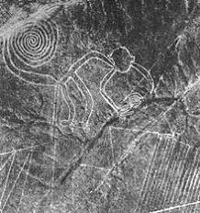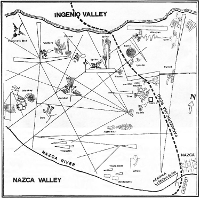Nazca Lines: Mysterious Geoglyphs in the Peruvian Desert
The Nazca Lines in the Peruvian desert depict geometric and animal-like shapes that can be discerned only from high up. Scientists know how these lines were created and when they were created–more than 1,500 years ago–but not why. 
The Nazca culture flourished in Peru from about A.D. 200 to about A.D. 700. Several times throughout their history, the Nazca people dragged a series of great rocks through the desert with deliberate attempt, creating shapes that look like a monkey and a hummingbird and several kinds of geometric shapes and at least one set of human-like figures. The largest figures are 1,200 feet long. 
Experts have studied the Lines off and on for the hundred years or so since they were discovered. So far, the scientists have identified hundreds of simple lines and geometric shapes, a large handful of tree- and flower-like shapes, and more than 700 animal-like shapes. Among the animal-like shapes found are birds, fish, jaguars, monkeys, and llamas. One of the most famous of the shapes depicts a spider. The Nazca Lines first appeared in print in a 16th-Century book by Spanish conquistador Pedro Cieza de León, who chronicled the Spanish conquest of what is now Peru. A Peruvian archaeologist walking through the desert rediscovered them. Then, an American historian flying over the area to study ancient irrigation systems identified one of the set of Lines as in the shape of a bird. Research by many other historians and archaeologists has followed. 
The Nazca people created their figures by digging a shallow trench of between 4 and 6 inches deep, removing the reddish-brown pebbles that form much of the Nazca Desert's surface material to reveal the light-colored clay underneath. The desert is one of the driest and least windy on Earth; that combination has helped to preserve the line patterns long after the Nazca culture was succeeded by others. Historians and archaeologists do not agree on the purpose of the creation of the Nazca Lines. Some people think that the shapes were created as a plea to deities that the people worshiped, perhaps asking for rain or good fortune. Another popular theory is that the shapes had some form of astronomical or astrological significance. The Nazca Lines have been a UNESCO World Heritage Site since 1994. Despite this, the Lines have been the target of a pair of high-profile incidents in recent years:
Even so, expeditions continue to add to the discoveries:
|
|
Social Studies for Kids
copyright 2002–2025
David White




